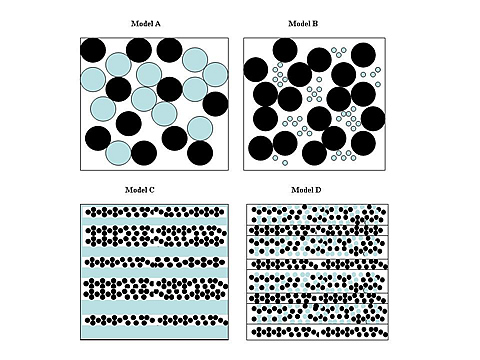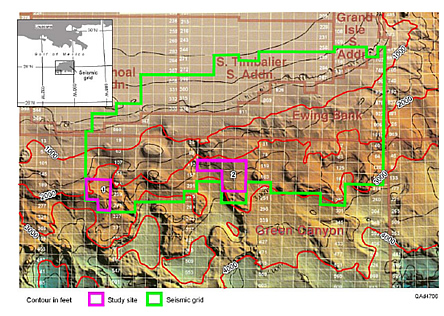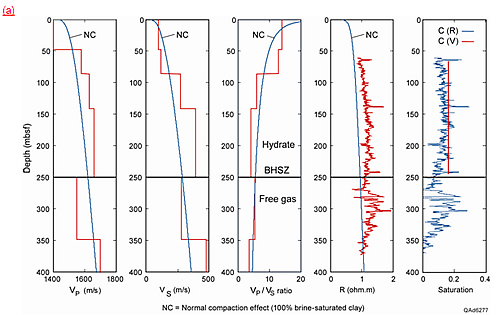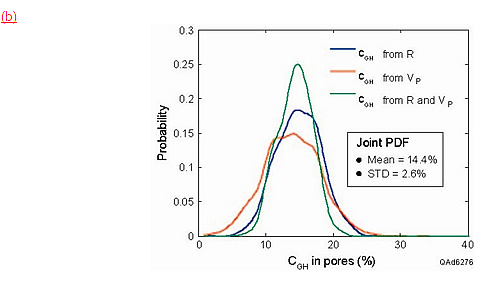In addition to the information provided here, a full listing of project related publications and presentations as well as a listing of funded students can be found in the Methane Hydrate Program Bibliography [PDF].
Final Project Report [PDF-23MB] - October, 2009
Technical Status Assessment [PDF-28KB]
Phase 1 Technical Report [PDF-798KB]
Phase 1 Technical Report (Research Database) [PDF-2.17MB]
Phase 2 Technical Report [PDF-5.04MB]
Project Continuation Report [PDF-1.67MB]
September 2007 Project Review [PDF-4.58MB]
2008 ICGH Paper - Assessing Fluid-Gas Expulsion Geology and gas Hydrate Deposits Across the Gulf of Mexico with Multicomponent and Multifrequency Seismic Data [PDF]
SEG 2008 Abstract [PDF-202KB]
Peer-Reviewed Publications
Sava, D., and B. Hardage, in review, Rock-physics models for gas-hydrate systems associated with unconsolidated marine sediments, in Collett, T., A. Johnson, C. Knapp and R. Boswell, eds., Natural Gas Hydrates: Energy Resource and Associated Geologic Hazards, The American Association of Petroleum Geologists Hedberg Special Publication.
Hardage, B.A., Roberts, H. H., Murray, P. E., Remington, R., Sava, D. C., Shedd, W., and Hunt, J. Jr.,Multicomponent seismic technology assessment of fluid-gas expulsion geology, Gulf of Mexico, , in Collett, T., A. Johnson, C. Knapp and R. Boswell, eds., Natural Gas Hydrates: Energy Resource and Associated Geologic Hazards, The American Association of Petroleum Geologists Hedberg Special Publication.
Government Reports
Hardage, B., M. Backus, M. DeAngelo, S. Fomel, R. Graebner, P. Murray, and L. Wood, 2002, Characterizing Marine Gas-Hydrate Reservoirs and Determining Mechanical Properties of Marine Gas-Hydrate Strata with 4-Component Ocean-Bottom-Cable Seismic Data, Final Report, DOE Contract No. DE-FC26-00NT41024.
Other Publications
Backus, M., P. Murray, B. Hardage, and R. Graebner, 2006, High-resolution multi-component seismic imaging of deepwater gas hydrate systems, The Leading Edge, Volume 25, n. 5, p. 578-596.
DeAngelo, M., M. Backus, B. Hardage, P. Murray, and S. Knapp, 2003, Depth registration of P-wave and C-wave seismic data for shallow marine sediment characterization, Gulf of Mexico, The Leading Edge, Volume 22, n. 2, p. 96-105.
Hardage, B., and P. Murray, 2006, Detailed imaging of deepwater hydrate geology with horizontal arrays of seafloor sensors, Proceedings of the Offshore Technology Conference, paper 17929.
Hardage, B., and P. Murray, 2006, High-resolution P-P imaging of deepwater near-seafloor geology, The American Association of Petroleum Geologists Explorer, Geophysical Corner, Volume 27, n. 7, p. 30.
Hardage, B., and P. Murray, 2006, P-SV data most impressive image, The American Association of Petroleum Geologists Explorer, Geophysical Corner, Volume 27, n. 8, p. 30.
Hardage, B., R. Remington, and H. Roberts, 2006, Gas hydrate--a source of shallow water flow?, The Leading Edge, Volume 25, n. 5, p. 634–636.
Hardage, B., and H. Roberts, 2006, Gas hydrate in the Gulf of Mexico: what and where is the seismic target, The Leading Edge, Volume 25, n. 5, p. 566-571.
Hardage, B., and H. Roberts, 2006, Evaluation of deepwater gas-hydrate systems, The Leading Edge, Volume 25, n. 5, p. 572-577.
McGee, T., and B. Hardage, 2006, Hydrate system to be monitored, The American Association of Petroleum Geologists Explorer, Geophysical Corner, Volume 27, n. 5, p. 24.
Roberts, H., B. Hardage, W. Shedd, and J. Hunt Jr., 2006, Seafloor reflectivity–an important seismic property for interpreting fluid/gas expulsion geology and the presence of gas hydrate, The Leading Edge, Volume 25, n. 5, p. 620–628.
Sava, D., and B. Hardage, 2006, Rock physics characterization of hydrate-bearing deepwater sediments, The Leading Edge, Volume 25, n. 5, p. 616-619.
Hardage, B. A., 2007, Gas hydrate and LNG tankers: AAPG Explorer, Geophysical Corner, v. 28, no. 5, p. 36.
Presentations
Backus, M., P. Murray, B. Hardage, and R. Graebner, 2005, Enhanced PS-wave images of deep-water, near-seafloor geology from 2-D 4-C OBC data in the Gulf of Mexico, 75th Annual International Meeting of the SEG, Houston, TX, November 6-11.
Hardage, B., and D. Sava, 2006, Seismic estimation of Gas Hydrate Concentrations in Deepwater Environments: Assumptions and Limitations, Houston, TX, The American Association of Petroleum Geologists Annual Meeting, April 9-12. (Winner of President’s Certificate for Excellence)
Hardage, B., 2006, Detailed imaging of deepwater hydrate geology with horizontal arrays of seafloor sensors, Houston, TX, Offshore Technology Conference, May 3.
Hardage, B., 2005, Assessing deep water gas hydrate systems and seafloor stability, invited lecture, New Orleans, LA, AGU, NABS, SEG, SPD/AAS Joint Assembly, May 23–27.
Hardage, B., and P. Murray, 2006, Detailed imaging of deepwater hydrate geology with horizontal arrays of seafloor sensors, paper 17929, 2006 Offshore Technology Conference, Houston, TX, May 1-4.
Murray, P., M. DeAngelo, B. Hardage, M. Backus, R. Graebner, and S. Fomel, 2005, Interpreting multicomponent seismic data in the Gulf of Mexico for shallow sedimentary properties: methodology and case history, Houston, TX, 2005 Offshore Technology Conference, May 2-5.
Sava, D., and B. Hardage, 2006, Rock physics models of gas hydrates from deep water, unconsolidated sediments, 76th Annual Meeting of the Society of Exploration Geophysicists, New Orleans, Louisiana, October 1-6.







